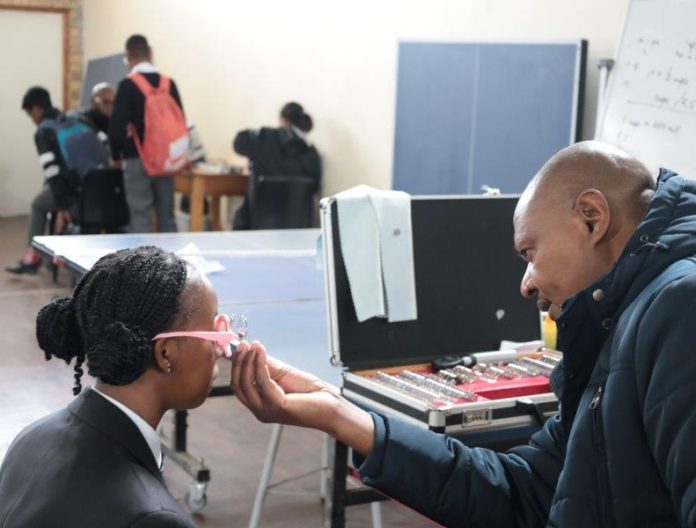CooperVision, the OneSight EssilorLuxottica Foundation, the African Eye Institute (AEI), Optometry Giving Sight, and Peek Vision are continuing the shared mission and pooling of resources to upscale, accelerate and expand access to eye health services to reach more children at more schools in South Africa through the One School at a Time (OSaaT) vision programme – part of the Berkeley Vision and the OneSight EssilorLuxottica Foundation global campaign.
Globally, an estimated one billion cases of vision impairment could have been prevented or can still be addressed[1], yet access to healthcare can be unaffordable. Addressing vision health early can have a life-changing impact on a person, helping to improve access to education, employment, and leading to increased self-confidence. To help provide South African children from disadvantaged families and underserved communities with those opportunities, the OSaaT programme expanded into Gauteng, the Eastern Cape, and the Western Cape in 2023.
“It’s been a challenging few years, but with the help of partners, we launched the OSaaT vision screening programme in 2021 and have continued to grow the service,” explained Prof Khathutshelo Percy Mashige, Chairman of the African Eye Institute (AEI), the non-profit organization that spearheaded the programme in South Africa. “We started with KwaZulu-Natal schools for the first two years of implementation but are excited to have expanded into more South African provinces in 2023. There is no greater joy than being able to help South Africa’s most vulnerable children by giving them the gift of sight, and we plan to continue growing the programme as we go on.”
One of the biggest threats to eye health among the youth is myopia (near-sightedness). Despite being corrected with spectacles or contact lenses in many cases, it’s become a significant public health issue, with an estimated 339.4 million children impacted worldwide. Moreover, the prevalence and severity of myopia is growing; it’s expected to affect more than 50% of the world’s population (almost five billion people) by 2050[2].
As a child’s myopia worsens, it can impact their life in various ways – from learning abilities and forging friendships to potentially sight-threatening conditions in adulthood, like cataracts, glaucoma, retinal detachment, and macular degeneration[3]. Early detection and treatment are crucial not only to enhance their immediate vision but also to help reduce future risks to their eye health.
“At CooperVision, we believe that access for every child to proper eye care is fundamental,” says Bruno Piroird, Head of Regional Marketing, Africa, Central Eurasia, and Central and Eastern Europe region. “By joining forces with the OneSight EssilorLuxottica Foundation, the African Eye Institute, Optometry Giving Sight, and Peek Vision, we strive to make a substantial difference in the lives of South African school children, empowering them to tap into their full potential and create brighter prospects for their future.”
Optometry teams working on the OSaaT programme visit schools in underserved communities to deliver accessible, comprehensive and high-quality eye health services for free. This includes vision screenings, eye examinations, referral services, and the provision of glasses to those who need it, helping to support better school performance and improved quality of life.
In line with this year’s World Sight Day theme, Love Your Eyes at Work, the OSaaT programme has been extended to screening teachers and auxiliary school staff, including cleaners, gardeners, and admin staff, ensuring they are also empowered to perform their daily work more efficiently and effectively.
Through the programme, OSaaT partners aim to raise awareness about the importance of eye health among children, teachers, and parents, while influencing policy and healthcare practices at national, regional, and global levels, alongside key organizations and stakeholders. Upscaling access to eye health services, early detection, and treatment can help reduce future eye health risks and support breaking the cycle of poverty. It also contributes towards growing the national and global economy as vision impairment contributes to a loss in productivity[4].
To create further impact regionally, the OSaaT team has established strategic partnerships with The Ruya Project for screening initiatives in Gauteng, the Special Projects Foundation to expand eye health services to schools in the Eastern Cape, and with Eye Save in the Western Cape to facilitate the extension of the OSaaT program to this province.
“The One Sight EssilorLuxottica Foundation believes partnerships are central to the strategy of scaling up eye care services. In order to create access to eye care for all children, irrespective of their socio-economic background. The OSaaT programme ensures that our collective efforts and expertise are mobilised in service of our children. Our partnership with governments ensures that sustainability is achieved by future integration of programs into national school eye health programs,” Professor Kovin Naidoo, Global Head Advocacy and Partnerships, OneSight EssilorLuxottica Foundation.
Since February 2023, the OSaaT programme has screened thousands of children at 48 schools. This was made possible by support from CooperVision, the OneSight EssilorLuxottica Foundation, the African Eye Institute, Optometry Giving Sight, and Peek Vision. The figures to date are:
47,497 children underwent a vision screening;
2,188 children received spectacles; and
1,164 children were referred to the nearest hospital/clinic for further care.
More information on the “One School at a Time” vision programme is available at https://coopervision.co.za/one-school-at-a-time.
[1] Increasing eye care interventions to address vision impairment, Technical Brief, World Health Organization, March 2023. Available at https://www.who.int/publications/m/item/increasing-eye-care-interventions-to-address-vision-impairment.
[2] Holden BA, Fricke TR, Wilson DA, Jong M, Naidoo KS, Sankaridurg P, Wong TY, Naduvilath TJ, Resnikoff S, Global Prevalence of Myopia and High Myopia and Temporal Trends from 2000 through 2050, Ophthalmology, May 2016 Volume 123, Issue 5, Pages 1036–104.
[3] Flitcroft DI. The complex interactions of retinal, optical and environmental factors in myopia aetiology. Prog Retin Eye Res. 2012;31:622-60.
[4] Prevalence and associated factors of vision loss in the South African National Health and Nutrition Examination Survey (SANHANES-1). BMC Ophthalmol 21, 1 (2021).












